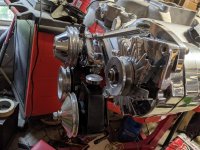In 1990 the 454 SS motor was introduced for trucks. This motor is a monster with fuel injection and vortec heads. It is easy to tell which is which by the block number. I know, I have one and built it up for a Corvette installation.
Also, there is a myth about so called "marine" accessories on boats. Marine is supposedly "hardened". That is not true anymore. All electric connections are safe now.
The big difference is the power output. If you are running two batteries and lots of accessories, you need a robust alternator. If you just go to Auto Zone and buy a cheap one, it won't generate enough power. Make sure you get one that will support your power draw. Same with a starter.
Also, do you really think that a car motor under a hood is less susceptible to damage from water than a boat in an enclosed engine compartment? I submit that the car motor and accessories take a much bigger beating from the garbage kicked up from the street and weather than being on the water.
I, personally, would not cut holes in the transom. I just don't see this as being a very good idea. If the the exhaust has a couple of bends in it, how much horsepower are you really gonna lose in your boat? Not many.
Paying for a custom exhaust is definitely an option....but why? Are you going racing? Do you just want to tool around at break neck speed? I believe your SS 454 will get the job done regardless.
It looks to me like you could easily find some marine elbows to fab an exhaust.
Marine rating on accessories has nothing to do with being hardened , what ever that meas.
marine rating is for components designed to prevent electrical sparks and gas vapors from igniting. This challenge is quite different in an enclosed marine engine compartment vs an engine on a car or truck where fuel valors can expell under the car.
main differences for components are
electrical like alternator, distributor, starter they are explosion proof typically screening and shielding which prevents sparks from getting outside the housing
carbs different bowl vents to prevent fuel spillage if bowl over fill and will have a port for mechanical fuel pump diaphragm rupture relief
mechanical fuel pump have a separate small line coming off that incase the diaphragm ruptures it will push fuel into the carb top and engine vs into the bilge.
water pumps marine have brass bronze or stainless impellers and backing plate and can run in either direction.
the basic engine itself is basically the same as a truck engine except marine head gaskets, brass freeze plugs, and cam has overlap and lobe separation angle such that you wont get reversion.






















